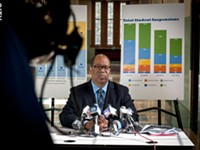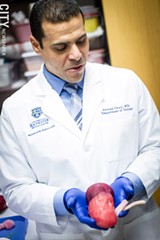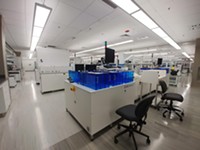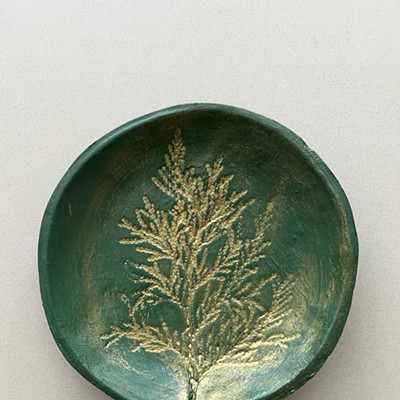[
{
"name": "500x250 Ad",
"insertPoint": "5",
"component": "15667920",
"parentWrapperClass": "",
"requiredCountToDisplay": "1"
}
]
Doctors Ahmed Ghazi and Jonathan Stone have the kind of personal synergy that lets them finish each other's sentences. Their enthusiasm about their research, which could change the way surgeons are trained, is impossible to ignore.
For the last three years, Ghazi, assistant professor in the University of Rochester's Department of Urology, and Stone, a neurosurgery resident who also has a degree in biomedical engineering, have been crafting artificial human organs. In a cramped laboratory where blood-red, blue, and fleshy pink stains have streamed down counters and over some expensive-looking equipment, the two show off kidneys, a liver, a gall bladder, part of a brain, and a boney section of spine. The organs are not for transplant; they're used for training surgeons. Thanks to a hydrogel that mimics the exact consistency of body fluids, they look and feel like the real thing. They even bleed when they're cut.
Ghazi and Stone have been creating 3-D printed models of real organs, and they're using them to simulate surgery. They call their research a Simulated Inanimate Model for Physical Learning Experience, or SIMPLE. Though they began much of their surgical training on pig parts and cadavers, surgery has changed radically in the last 20 years due to technology, they say. And the number of procedures being performed is increasing as well, which has put greater focus on precision and better surgical outcomes.
Ghazi and Stone wanted to determine whether training surgeons on a simulated model improves patient outcomes. Can a new surgeon gain a better sense of what may happen in the operating room through simulation? Can seasoned surgeons up their game? Can overall hospital care improve?
A lot of medical research is focused on gene therapy right now, which is incredibly important, says Ghazi. But in many instances, translating that work to a vaccine or a cure may be years away and hugely expensive, he says. And Ghazi and Stone are looking for more immediate results by paying closer attention to skill, he says.
Surgery that's almost real from CITY Newspaper on Vimeo.
Their research couldn't be timelier, considering that roughly 234 million major surgeries are performed worldwide yearly, according to US News and Report World. Surgery rates are higher in more developed and wealthier countries, but the rates are rapidly increasing in developing countries. And so are complications after surgery.
A study recently reported in the New England Journal of Medicine examined surgical readmission rates and quality of hospital care, issues that are critical to clinicians, administrators, and policy makers. Using readmission rates to judge the quality of a hospital is controversial, since studies show that hospitals that treat the poorest and sickest populations are frequently those with higher readmissions. But the NEJM study makes a distinction when it comes to surgery, arguing that readmission following surgery could mean something else is happening, since most major surgery is planned and is performed when the patient is in stable condition.
"Surgical patients are more likely to return as a consequence of complications arising from the surgery," the study's authors say.
Ghazi and Stone had a strong hunch that many complications that occur during and after surgery could be avoided through training that more realistically replicates surgery. In an example of how the process begins, Stone refers to the case of a patient who was diagnosed with kidney cancer. A CT scan on a computer screen shows the ominous-looking mass growing on the kidney.
"This case was a high-risk patient, because they have a bleeding disorder," Stone says. "Some doctors might decide to just take the kidney out. Don't risk the blood loss. Dr. Ghazi wanted to try a minimally invasive approach using a robot, which would spare this guy a big surgery and reduce his length of stay."
Ghazi and Stone could speculate about the location of the blood vessel feeding the tumor based on the scan, but by creating a 3-D model of that patient's kidney, Ghazi could better understand what the actual surgery would involve.
Converting the patient's scan into an exact copy of that organ so that it looks, feels, and bleeds just like the patient's allowed Ghazi to practice before the actual surgery, Stone says. "It's a technical exercise," he says.
Ghazi tells his students that performing every surgery is like opening Pandora's box.
"It takes a very long time to train to become a surgeon, because anything can happen, and what you're doing is learning how to react in the operating room," Ghazi says. "By offering preemptive preparation, your need to react is lessened because you're expecting what will happen."
Ghazi holds the kidney and points to the tumor he removed. It's large, and Ghazi expected a lot of bleeding. He could also see that certain structures of the kidney would be injured and need to be repaired.
"To get to the tumor, you have to dig through this, and this is a hornet's nest," he says, pointing to a cavity in the reddish-brown organ.
Ghazi and Stone don't just create a single organ, which is another distinction of their work. They create the surrounding organs, too. Zero risk is involved; even the materials used are non-toxic and biodegradable.
In another example, Ghazi had to remove a large kidney stone. Stones the size of this one, which was starting to fill the whole kidney, are sometimes referred to as stag-horn masses because of their size and branched shape. They're difficult to remove and usually involving long hospital stays. By recreating the patient's kidney as well as the vertebrae and rib cage, Ghazi was able to better target the stone.
"What we're doing is recreating the entire experience: all of the organs, all of the steps of the procedure, using the same exact instruments, and within the same environment where you'll be operating," Ghazi says.
The researchers' initial results from SIMPLE have been exceptional, Ghazi says. "What we're doing right now is looking at the simulation and the outcomes of the patients," Ghazi says. They've succeeded at simulating surgery from beginning to end that is so realistic that some nurses and doctors who have looked into the OR assumed they were seeing real surgery underway.
They've already seen a marked improvement in the surgical process, he says.
"Currently we're training all third-year medical students, so about 110 students are going through this process," Ghazi says. Some engineering students from Rochester Institute of Technology are also involved in the research.
Ghazi and Stone's work is a good example of the UR's thrust into what officials refer to as translational science. The tools and talent of multiple disciplines are applied to a particular problem. While most research has been benchtop to bedside, they call their research benchtop to operating room.
The next step is to see if the patients with surgical rehearsals actually have fewer complications, blood transfusions, and readmissions. Ghazi and Stone want to know whether the improvements warrant using the simulation rehearsals on all surgeries or only the most complex.
"Our first concern is for the patient, and we know that there is a clear correlation," Ghazi says. "But ultimately, we're not only trying to address patient outcomes. We're trying to address health care costs."
Speaking of...
Latest in News
More by Tim Louis Macaluso
-

RCSD financial crisis builds
Sep 23, 2019 -

RCSD facing spending concerns
Sep 20, 2019 -

Education forum tomorrow night for downtown residents
Sep 17, 2019 - More »









